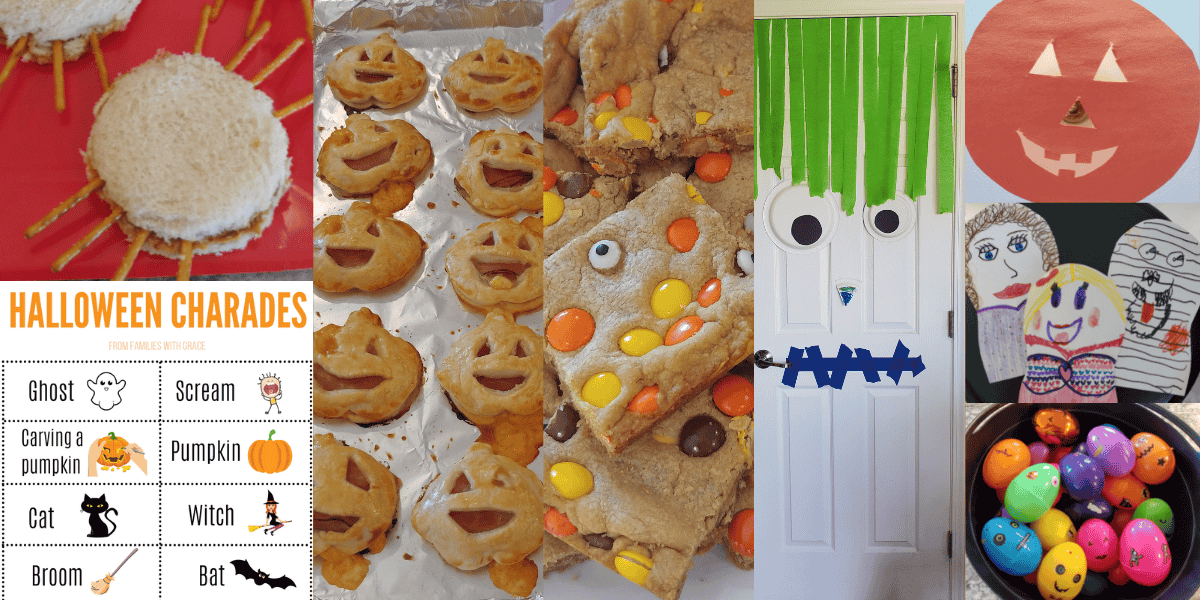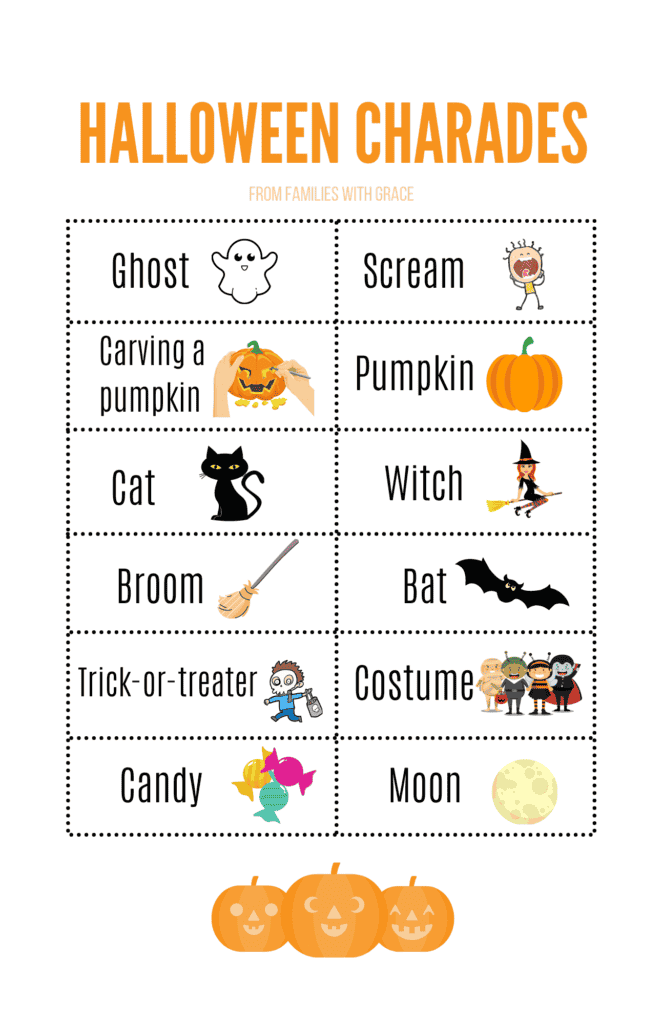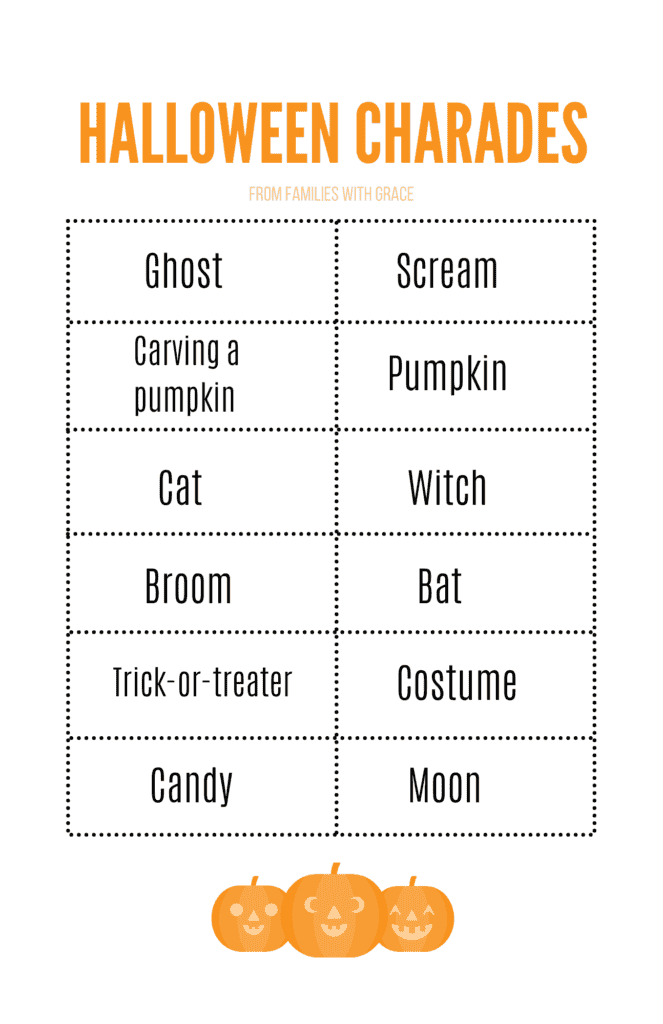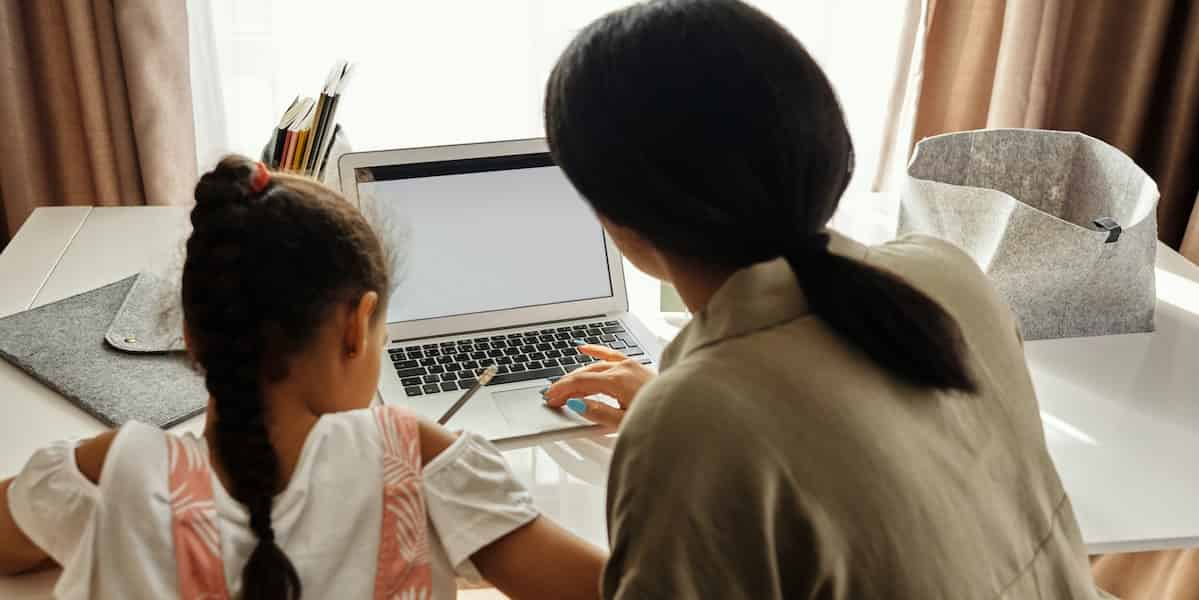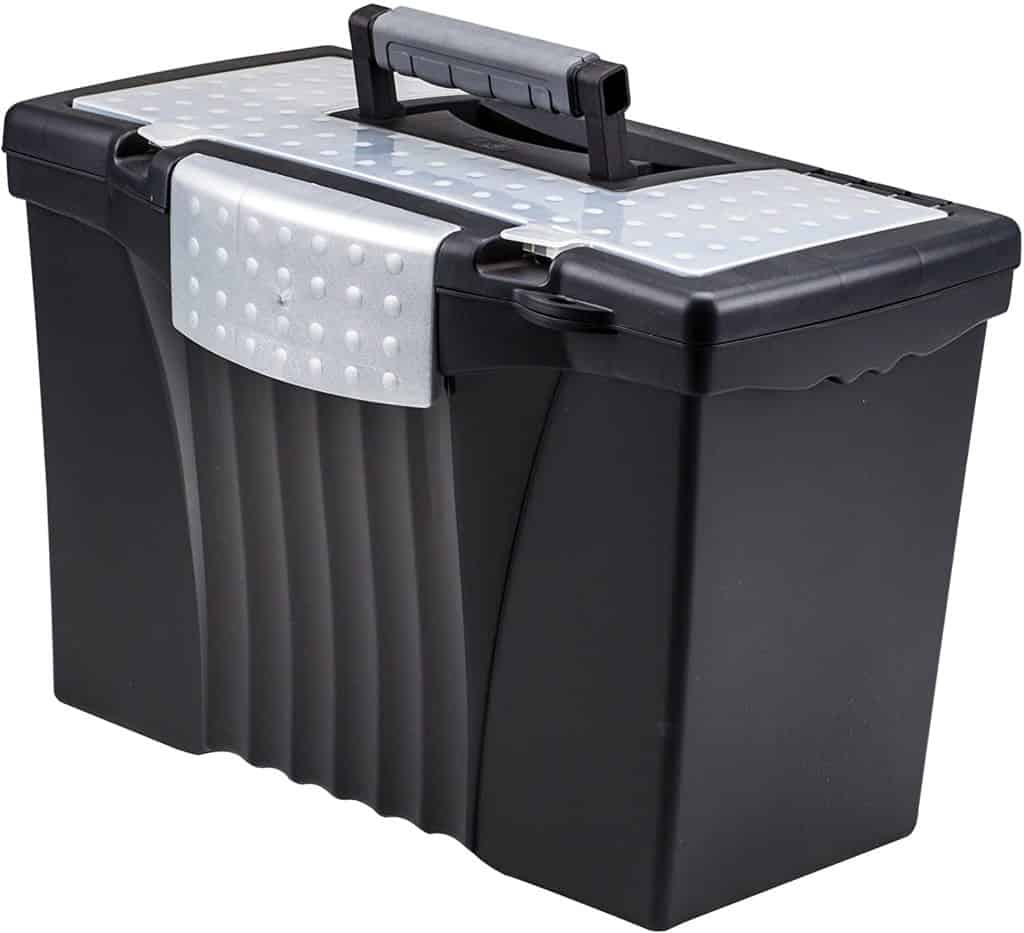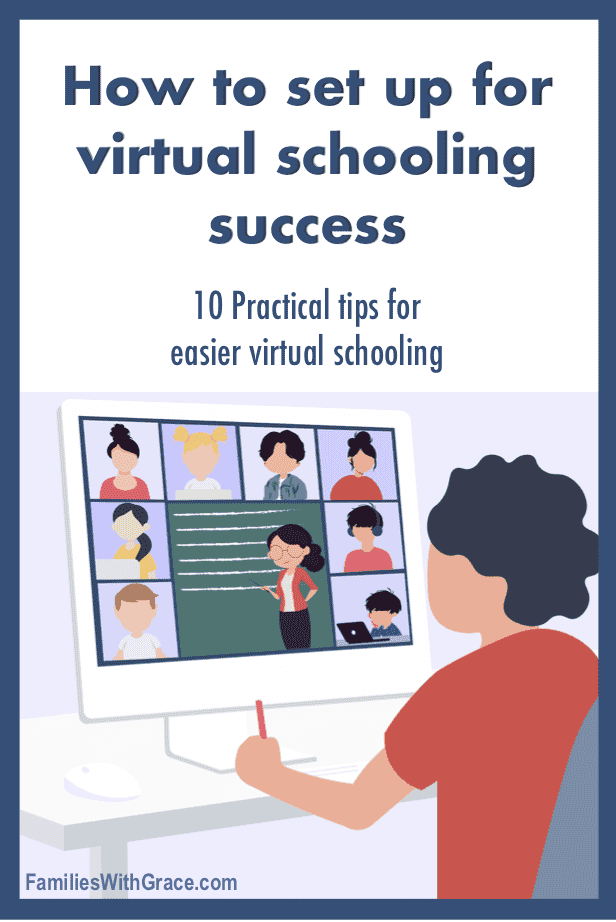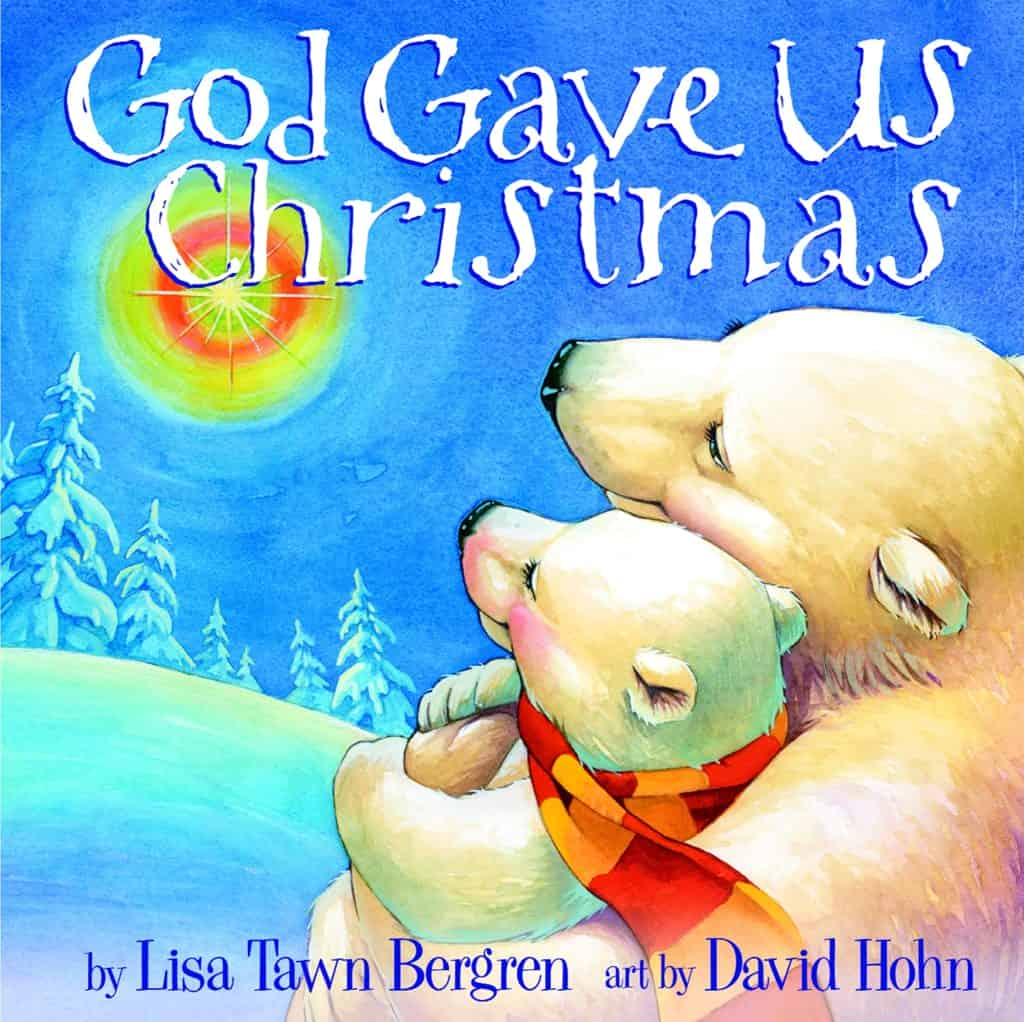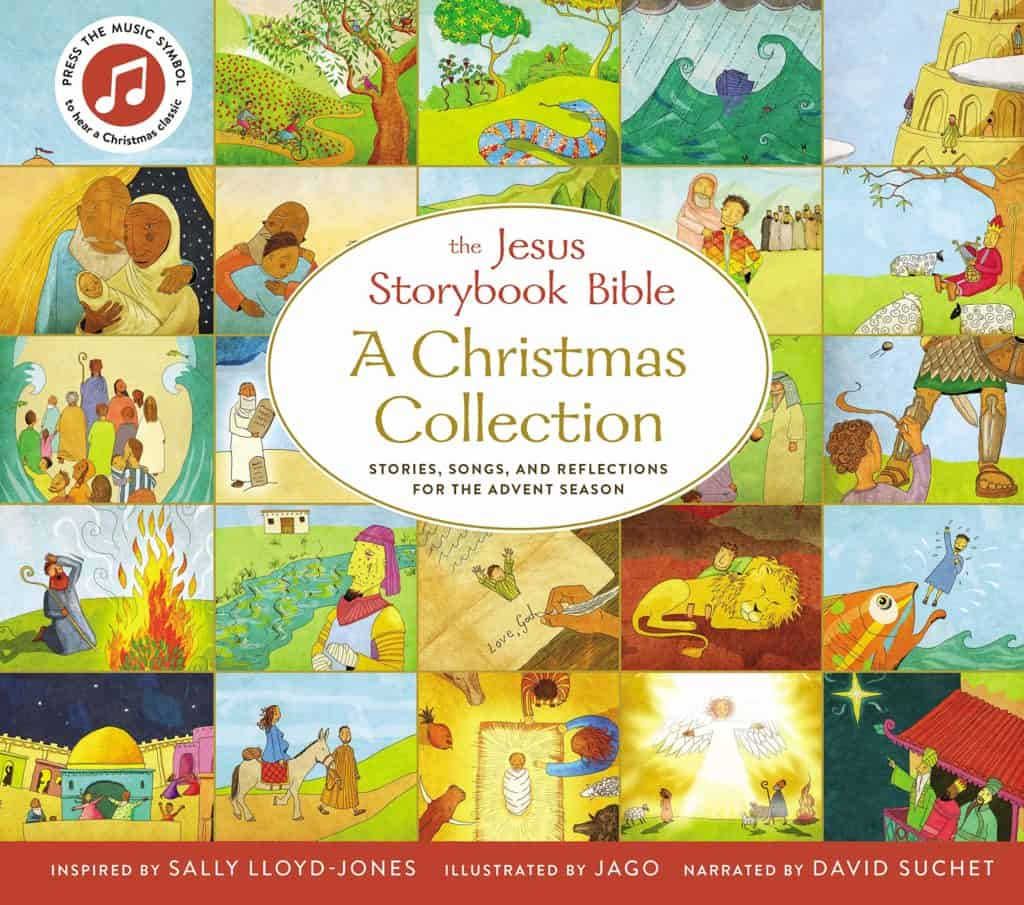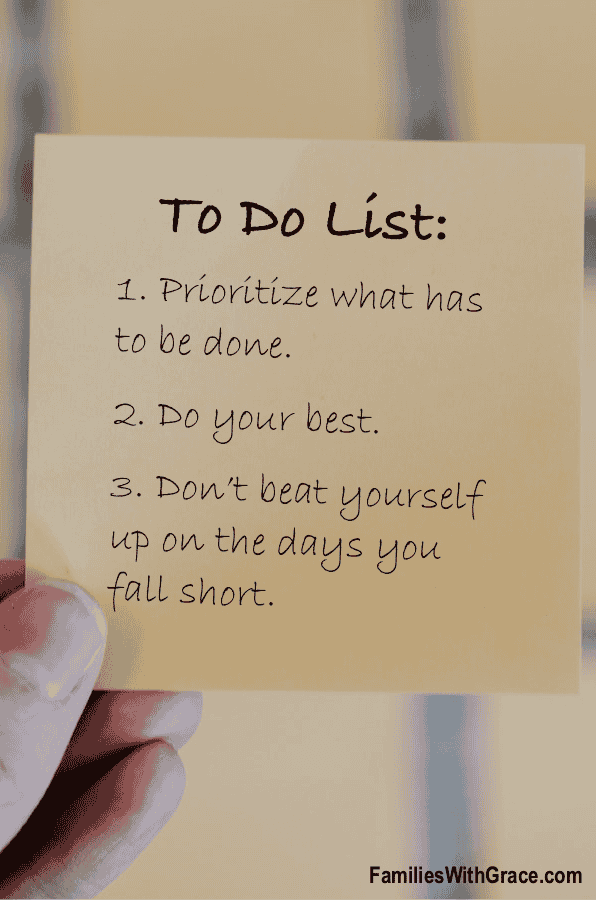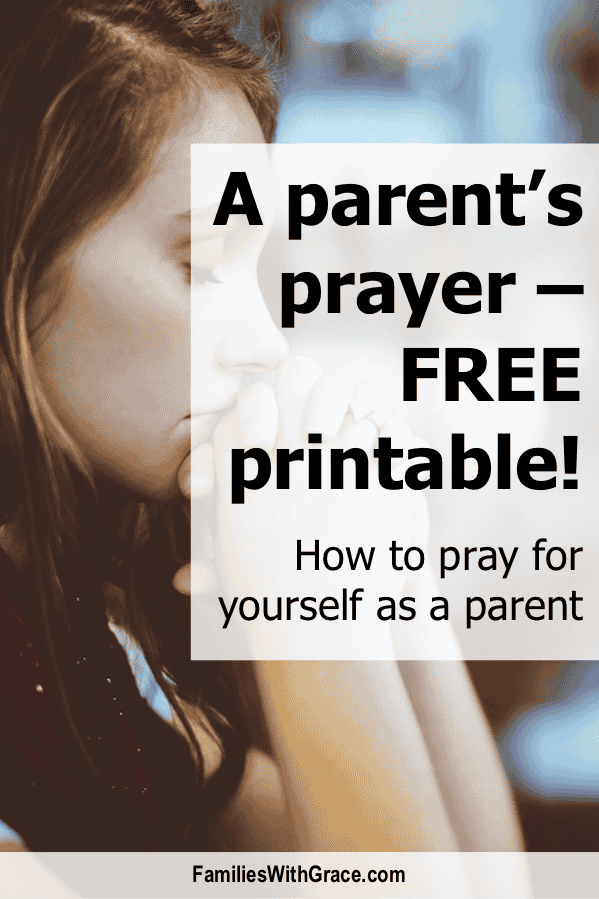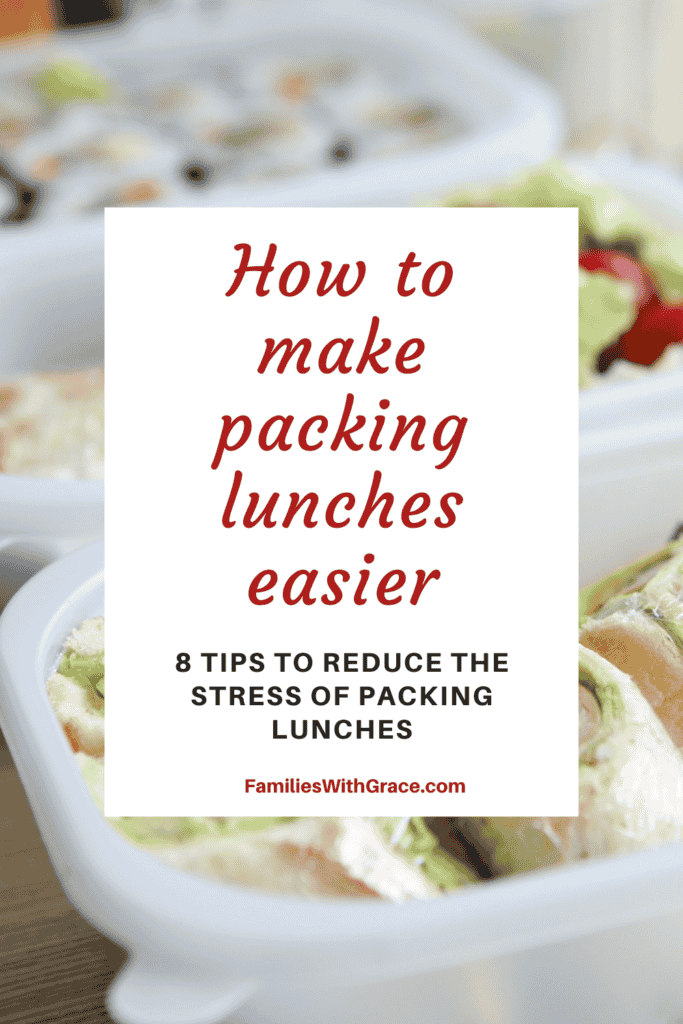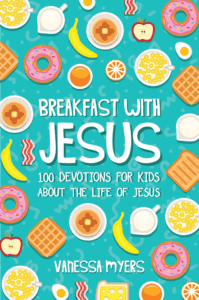Everything you need for a fun and easy Halloween party at home!
Affiliate links are used in this post. If you make a qualifying purchase via my link, I receive a small percentage of the sale at no additional cost to you. I only recommend products and services I use and love. It helps support my blog, so thank you for your support! Read my full disclosure here.

Last year we knew that trick-or-treating wouldn’t be an option for our kiddos in the midst of COVID-19. This year, things aren’t looking so great either. But we did learn last year how to throw a fun Halloween party at home that our kids enjoyed more than even trick-or-treating. I know. It was hard for me to believe, too. And the party didn’t take lots of planning, time or money.
Because we had all sheltered in, we included grandparents for our Halloween celebration. Everyone wore a costume. We had snacks, games and lots of fun! Most of the decorations were things my family and I made, which is an accomplishment considering I’m craft-challenged. But it all turned out great!
Halloween party DIY decorations
Decorations that are easy to do are my favorites. And all of these are easy. Basically with some construction paper, markers, crayons and scissors you can make most of them! (I did very little shopping for this party. Most stuff I had on hand at home because it was so basic!)
Paper ghosts
One of the biggest hits for our decor was these paper ghosts. When it comes to Halloween, I’m all about fun decorations and not scary ones. So I cut out some ghost shapes out of white construction paper and then my husband, kids and I all decorated them. We had various themes for each of them. They turned out so incredibly cute! We hung them with fishing line and tape.

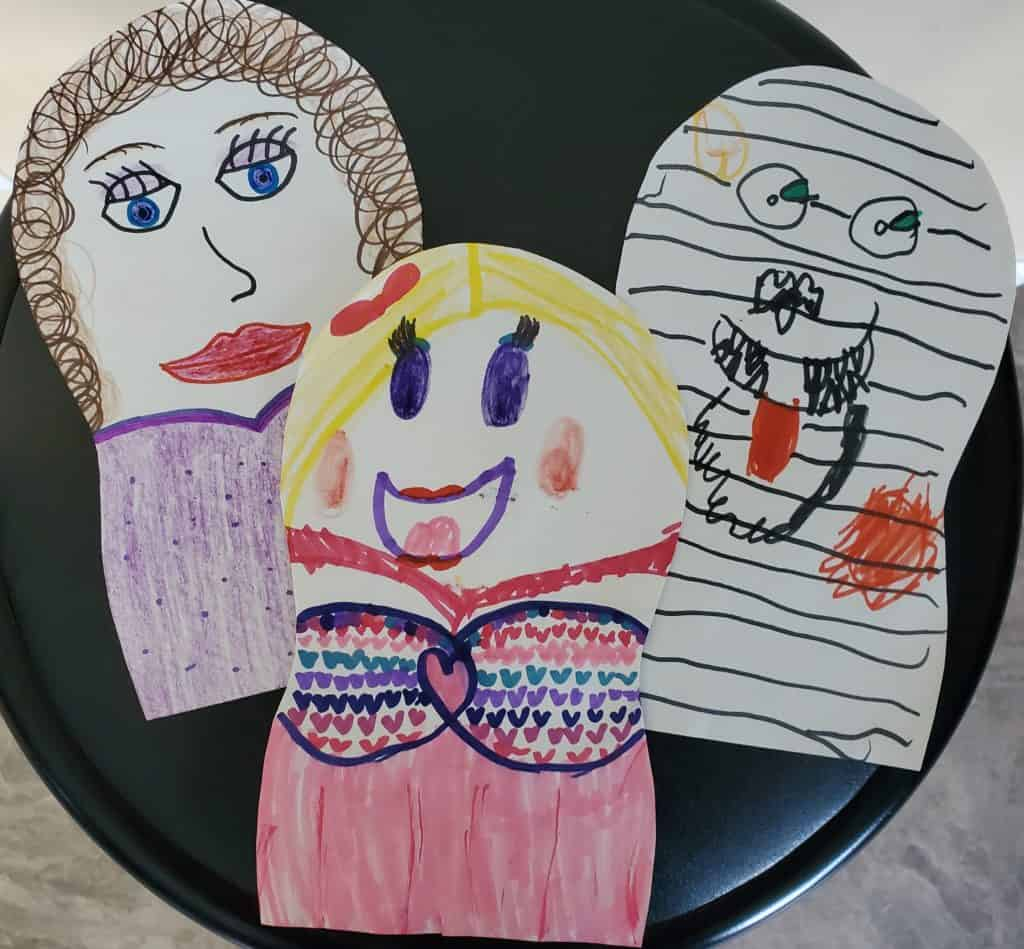
Light covers
My original plan was to cut out pumpkin shapes and have us decorate them. Then my son suggested that instead we cut jack-o-lanterns out of construction paper and tape them to our dining room light. It was cute. They didn’t look perfect, but that didn’t matter. They turned out well and were nice and festive.
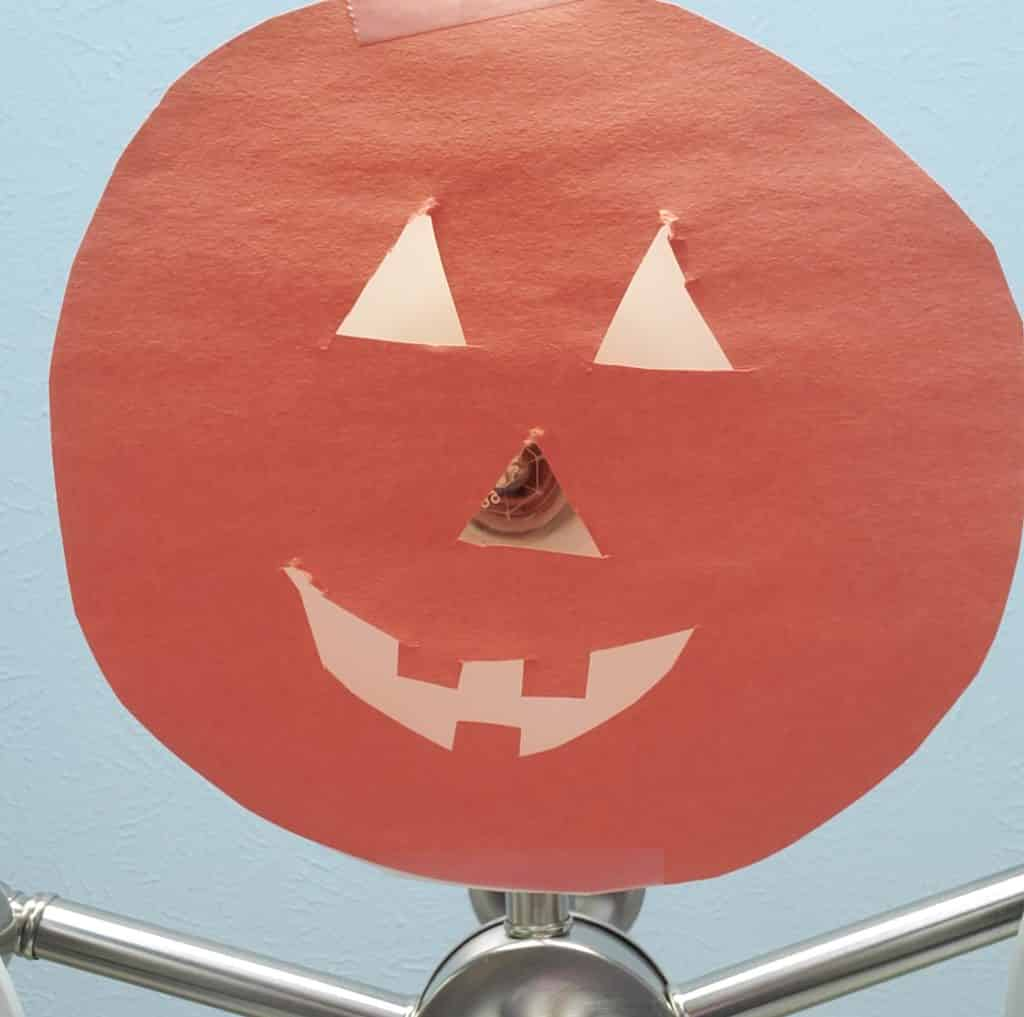
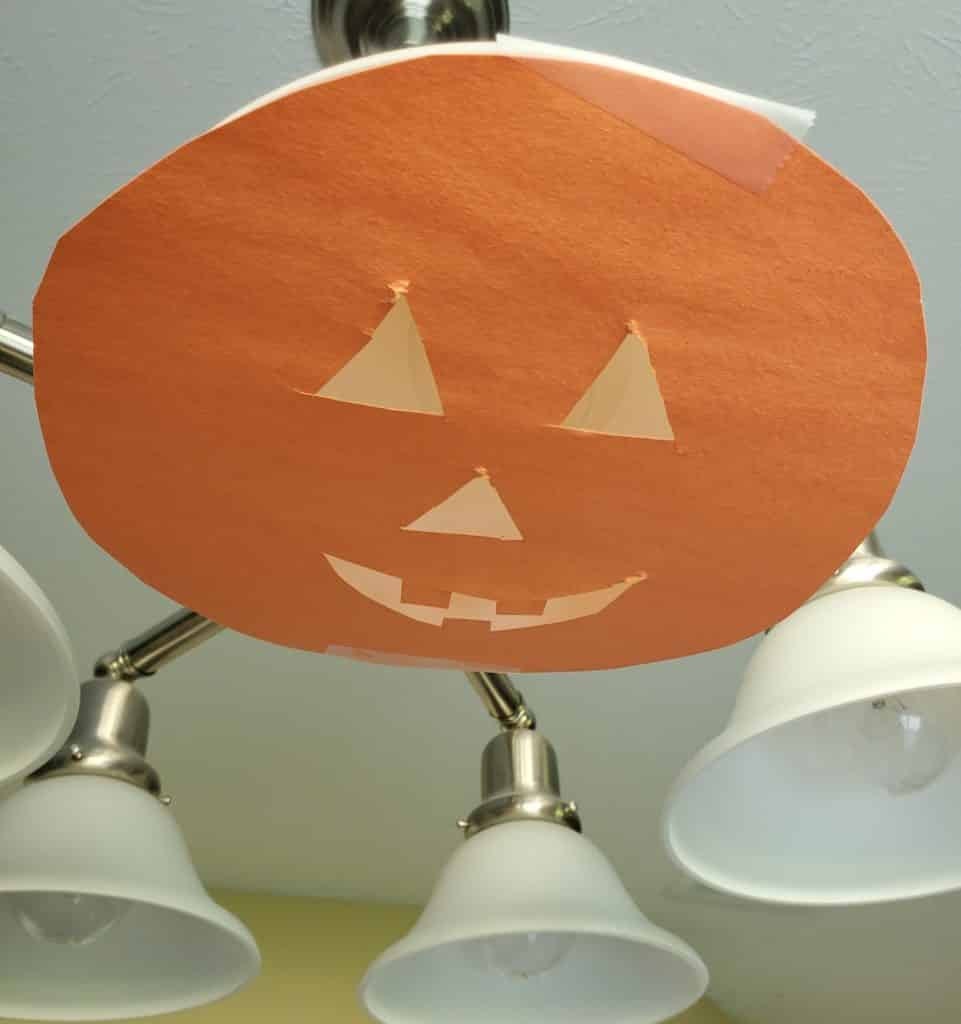
Monster door
This monster door isn’t new to us. We did this a couple of times on the front door at our old house. But especially since we were almost never leaving the house, I decided to have the monster door be inside instead on our pantry door. We just used crepe paper (which I had from birthdays), paper plates, 2-inch painters tape and markers.
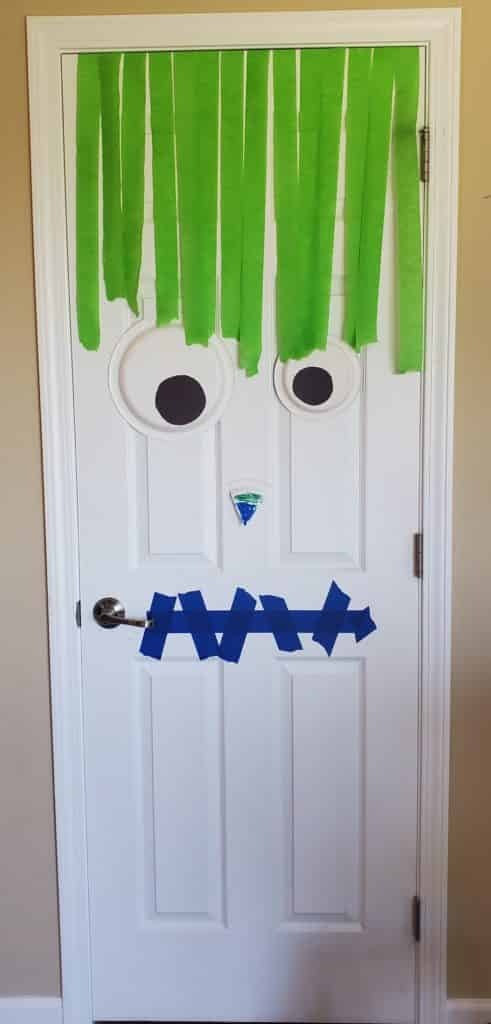
I flipped over the paper plates. We had two sizes, so we made his eyes different sizes this year, but we have also made them the same size. Then I cut out black circles to glue onto the plates and make the eyes. My son cut a nose out of a paper plate and colored it. You can also make the nose with construction paper. Then painters tape made up the mouth. Easy peasy and adorable! We had the monster door at our house for most of the month of October.
Jack-o-lanterns
Of course you can’t forget jack-o-lanterns for Halloween. We let each of our kiddos pick out a pumpkin and then decide how they wanted to decorate it. One decided to carve and the other decided to paint. For the carved pumpkin, we used a battery-powered tea light inside of it. We set both of them on the hearth of the fireplace for additional ambiance.


Easy and delicious Halloween-themed food
Every good party has to have food! I didn’t want to order pizza, because Halloween is one of the busiest nights for pizza places. And I also wanted to control when the food was ready so we weren’t waiting around for it. I’m not a master chef, but I found a few recipes that were festive and went well for our party. I served up some grapes, a veggie platter and cheese balls along with the following festive Halloween food.
Jack-o-lantern sandwiches
Of all the food I made for the party, this took the most time simply because I had to cut out the jack-o-lantern faces. But they turned out so cute that I’d totally do it again. And they were so delicious! Refrigerated pie crusts give these a decadence that works well with the salty ham and cheese.

Jack-o-lantern ham and cheese pockets
Ingredients
- 1 box refrigerated pie crusts
- 8 oz. thinly sliced Black Forest or Virginia ham
- 8 oz. thinly sliced Cheddar or Swiss cheese
- 1 large egg beaten
- 1-2 tbs. honey mustard
Instructions
- Heat the oven to 425-degrees. Line a rimmed baking sheet with nonstick foil.
- Unroll the pie crusts. Use a 3-inch cookie cutter to cut each crust into 24 pumpkin shapes. With a sharp knife, cut out eyes and a nose from 12 of the cutouts. Place the 12 plain pumpkins on your baking sheet.
- Top each of the plain pumpkin cut-outs with a slice or two of ham, folded to fit. (You could also cut out the ham into circles, but that seemed like too much extra work to me!)
- Put about 1/2 teaspoon of honey mustard on top of the ham.
- Layer a slice or two of cheese on top of that and then top with another slice or two of ham. (I say "a slice or two" because it depends on your preference. I did one slice each with mine because my family's preferences.)
- Brush the beaten egg around edges. Top with the pumpkins faces, then carefully press on the edges to seal.
- Brush tops with beaten egg.
- Bake for 12 to 15 minutes until light golden.
- Let them cool for about 5 minutes before serving.
Reese’s Pieces cookie bars with eyes
I love Reese’s Pieces. They are so incredibly good. When I came across this recipe from Betty Crocker for Reese’s Pieces cookie bars that included candy eyes, I knew I had to make them for our Halloween party at home. I love that these can be made ahead of time. Cookie bars are also grand because you just mix them, bake them in one pan and then cut them. They’re less work than making actual cookies. This particular recipe uses a pouch cookie mix, so it’s even easier. Look how cute they are! And so yummy!

Sweet festive popcorn
I love popcorn. My mom and son love it, too. I was curious when I came across a recipe for sweet popcorn, so I decided I had to try making it. I learned some things from the Halloween batch I made and made it better at Christmas. So, I’m going to show you the Halloween batch, but give you the instructions I learned later to make it better!

Ingredients
2 bags of microwave popcorn, popped
1 12-ounce package of candy melts (I used orange for Halloween)
Halloween sprinkles, optional
Directions:
1. Pop two bags of white popcorn in the microwave. Spread it out on wax paper or parchment paper.
2. Put the candy melts in a microwave-safe bowl. (I used a large glass bowl.)
3. Heat the candy melts in the microwave in 30-second intervals, stirring in between, until they are fully melted.
4. Carefully pour the melted candy over the popcorn. Move the popcorn around with a spoon if needed to get most of the pieces coated.
5. Sprinkle the sprinkles over the top if desired.
6. Let it sit until cool before placing it in a bowl. Store in an airtight or zip-top container. It lasts for a few days of snacking!
PBJ spider sandwiches
Since my husband and son are more particular eaters who I knew wouldn’t eat the ham and cheese pockets, I looked for something they’d enjoy. These PBJ spider sandwiches were just the thing! I made both PBJ and plain peanut butter sandwiches (as you can see from the smear on one in the photo to denote it is plain). My son doesn’t like jelly.
I used a drinking glass to cut the sandwiches into rounds and then stuck in the pretzel stick legs. Easy-peasy and festive. These would be great to send in your kiddo’s lunchbox on Halloween as well!

Fun, simple Halloween party activities
While decorations set the mood and food makes everyone happier, you still need activities for a party to be successful. We’re a relatively low-key bunch, and we live in the Midwest where it can be 75-degrees on Halloween or 30-degrees. We didn’t want to risk planning anything outside. But we came up with some good options and both kids and adults had fun during our Halloween party at home.
Monster egg hunt
The biggest thing for our kids at Halloween is trick-or-treating. During the pandemic, that wasn’t possible. We debated about how to make it happen. We thought about stationing ourselves and our grandparents in different rooms around the house for the kids to visit and get candy from. But then I came across the idea of monster eggs. And that’s what we went with.
Before the party, I tracked down our plastic Easter eggs that were brightly colored, got out some Halloween stickers and got to work making the eggs look a bit more Halloween-ish. I had some face stickers left from a Halloween craft we’d done the previous year and then other Halloween stickers as well. (I love stickers, so I didn’t have to buy any. But if you aren’t a sticker-loving fiend like I am, you can either purchase Halloween stickers or use a Sharpie to draw on them.)
Once they were decorated, I filled the eggs with candy. During the party, we sent the kids upstairs and some of us adults hid the eggs all over downstairs for the kids to come and find. They had fun doing so, and we had the challenge of trying to remember where we put all the eggs! In the end, everyone ended up with candy and was happy. (I kept a candy bucket sitting out throughout the night as well.)

Pumpkin ring toss
When we were shopping for pumpkins to decorate, we also looked for a small pumpkin with a tall stem. (Pie pumpkins are a perfect size for this!) We found one and brought it home. Armed with some glow bracelets, we turned off the living room light during our Halloween party at home and had a ring toss to see who could get the most rings (a.k.a. glow bracelets) on the pumpkin’s stem.
Halloween charades
Charades is one of my kids’ favorite games to play. So, we had to include it for some Halloween party fun. We came up with our own ideas, so I’ve put them together in a free printable for you. There are two versions: one with pictures and one without. If you have an early reader who wants to participate, the one with pictures would work well for triggering their reading. I like the picture version as well to make it easier for my 8-year-old who is dyslexic. Click on either image to download and print the version you prefer.
Halloween Bingo
Our final activity for our Halloween party at home was Halloween Bingo. You can buy adorable Halloween Bingo games online. Or you can find free printable ones to use. Since we had a small group, I went with the free printable route and then we used candy corn for our game markers. Yep, we totally snacked on some along the way. If you don’t like candy corn, you can use another candy, marshmallows or even cereal to mark your game.
My favorite site for free printables for games and activities is DLTK Kids. (I have no affiliation with them whatsoever.) They offer lots of easy-to-customize options. I have used their site many times for Sunday School classes and my own kiddos. DLTK Kids has a page full of a variety of Halloween activities for kids, including Halloween Bingo.

